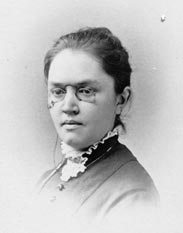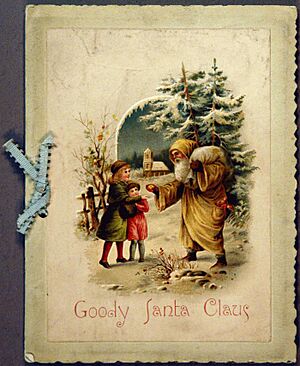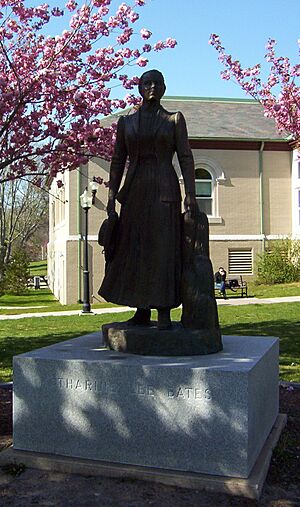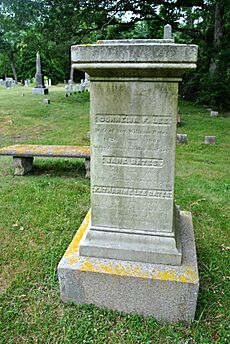Katharine Lee Bates facts for kids
Quick facts for kids
Katharine Lee Bates
|
|
|---|---|

Sketch from A Woman of the Century
|
|
| Born | August 12, 1859 Falmouth, Massachusetts, U.S. |
| Died | March 28, 1929 (aged 69) Wellesley, Massachusetts, U.S. |
| Resting place | Oak Grove Cemetery, Falmouth, MA, |
| Occupation |
|
| Genre | Poetry |
| Notable works | "America the Beautiful" Goody Santa Claus on a Sleigh Ride |
| Notable awards | Golden Rose Award |
| Partner | Katharine Coman |
| Signature | |
 |
|
Katharine Lee Bates (born August 12, 1859 – died March 28, 1929) was an American writer and poet. She is best known for writing the words to the famous song "America the Beautiful". She also wrote many books and articles about making society better. Bates was a well-known speaker on these topics.
Bates had strong ties to Wellesley College in Massachusetts. She earned her degree there and later became a professor of English literature. She helped make American literature a special subject to study in colleges. She even wrote one of the first textbooks about it. Bates never married. Throughout her long career at Wellesley, she shared a home with her close friend and companion, Katharine Coman.
Contents
Life and Career of Katharine Lee Bates
Katharine Lee Bates was born in Falmouth, Massachusetts. Her father, William Bates, was a minister. He died just a few weeks after she was born. Her mother, Cornelia Frances Bates, and a literary aunt raised her. Both women had graduated from Mount Holyoke Seminary, a college for women.
Katharine went to Wellesley High School and then Newton North High School. In 1876, she joined the second class of students at Wellesley College, a women's college. She earned her bachelor's degree in 1880. After college, she taught at Natick High School and Dana Hall School.
In 1889, Bates won a prize for her book Rose and Thorn. This book was for young adults. It featured characters who were poor or working-class women. The story taught readers about the need for social improvements. Bates also made the idea of Mrs. Claus more popular. She did this in her poem "Goody Santa Claus on a Sleigh Ride." This poem was part of her book Sunshine and other Verses for Children (1889). In the poem, Mrs. Claus is the main organizer of Christmas Eve.
Studies and Travel Abroad
After the American Civil War, new chances for education opened up for women. Bates used her prize money from Rose and Thorn to travel. She went to England and studied at Oxford University in 1890–91. After her studies, she returned to Wellesley College. She became an associate professor in 1891. She earned her master's degree there and later became a full professor of English literature.
Near the end of the Spanish–American War, Bates worked as a war reporter for The New York Times. She tried to change negative ideas about Spanish people. She wrote regularly for many magazines. These included The Atlantic Monthly and Boston Evening Transcript. Sometimes, she used the pen name James Lincoln.
In 1900, she wrote Spanish Highways and Byways for The New York Times. This book described the beautiful landscapes of Spain after the war. It also talked about the political and social situation she found there. Bates had a unique way of describing things. She used a "picturesque" style to show not just nature and art, but also the people themselves.
Later Life and Activism
In 1906, Bates and her brother, Arthur, bought land in Wellesley. They built a house there for their family. Katharine Coman was one of their tenants. She rented an attic bedroom. While the house was being built, Bates traveled to Egypt. She named her new house "The Scarab." This was after the sacred Egyptian beetle she admired. She said it was "always climbing."
While working at Wellesley, Bates became a member of Pi Gamma Mu. This is an honor society for social sciences. She joined because she was very interested in history and politics. Bates retired from Wellesley in 1925 when she was 66 years old. Even in retirement, she kept writing and publishing poetry. Many people wanted her to write and speak.
Bates was also a social activist. She cared deeply about the challenges faced by women and workers. She also cared about people of color, people living in poor housing, immigrants, and poor people. In 1892, she helped start Denison House. This was a settlement house for college women. She wrote and spoke a lot about the need for social improvements. She strongly supported the global peace movement that began after World War I. She worked hard to help create the League of Nations.
Bates had been a Republican for a long time. But in 1924, she supported the Democratic presidential candidate, John W. Davis. She did this because the Republicans were against the U.S. joining the League of Nations. She felt they had "betrayed" Woodrow Wilson and rejected the League. Bates saw herself as a "global citizen." She spoke out against America's policy of staying out of world affairs.
Katharine Lee Bates died in Wellesley, Massachusetts, on March 28, 1929. She was 69 years old. She passed away while a friend was reading poetry to her. She is buried in Oak Grove Cemetery in Falmouth. Most of her writings are kept at the Wellesley College Archives.
"America the Beautiful"
Katharine Lee Bates wrote the first version of "America the Beautiful" in the summer of 1893. She was teaching English at Colorado College in Colorado Springs, Colorado. She later remembered: "One day some of the other teachers and I decided to go on a trip to 14,000-foot Pikes Peak. We hired a prairie wagon. Near the top we had to leave the wagon and go the rest of the way on mules. I was very tired. But when I saw the view, I felt great joy. All the wonder of America seemed displayed there, with the sea-like expanse."
Bates had experienced unfair treatment because she was a woman. She had also seen the harsh effects of the industrial revolution in America and Britain. She saw poverty and hardship in cities. She strongly wanted everyone to be treated equally. This wish for a fair American community inspired her poem. She wrote it during a difficult economic time in 1893.
The words to her famous poem first appeared in print in The Congregationalist. This was a weekly newspaper. It was published for Independence Day in 1895. More people read the poem when her updated version was printed in the Boston Evening Transcript in November 1904. Her final, longer version was written in 1913. On November 11, 1918, a group of soldiers from the U.S. Army sang "America the Beautiful." This happened when they heard that World War I had ended. The song has been sung to several tunes. The most well-known tune was written by Samuel A. Ward for his hymn "Materna."
Katharine Bates and Katharine Coman's Friendship
Katharine Lee Bates and Katharine Coman were both professors at Wellesley College. They were close friends and sometimes traveled together. Coman also lived in Bates's "Scarab House." Their friendship has been discussed by scholars for many years.
Melinda M. Ponder wrote a book about Bates in 2017. She described Bates as an independent social activist. Bates set an example for women to be smart and independent in the late 1800s. Bates's personal writings show her strong friendships with several women. They also show her deep feelings for two men she knew. Bates never married. If she had married, she might have lost her teaching job at Wellesley. She also would have lost some of the independence she valued.
Bates destroyed most of the letters she and Coman wrote to each other. A few letters survived. One letter from Bates to Coman in 1893 said: "You are always in my heart and in my longings... It was the living away from you that made, at first, the prospect of leaving Wellesley so heartachy." Ponder highlights how important Coman was to Bates. Coman showed Bates how professors could "challenge accepted attitudes towards women's social, economic, cultural, and gender roles." Bates wrote a series of poems called "In Bohemia." In these poems, she celebrated the "vitality, adventurous spirit, and abiding spiritual presence of their love."
Coman and Bates met at Wellesley by 1890. The college president, Alice Freeman Palmer, wanted to add more women to the faculty. Coman taught history and economics. She also started the Economics Department at Wellesley College. During her lifetime, Coman was almost as famous as Bates. Both women became influential and independent in their fields. Bates's work continues to impact American life and literature today.
After Coman died from breast cancer in 1915, Bates wrote a memorial for her. This is believed to be the first American story about breast cancer. Bates wanted this writing to be shared only among their close friends and family. In 1922, Bates published Yellow Clover: A Book of Remembrance. This book was a collection of poems she had written for Coman. She dedicated the book to Coman, calling her "my Friend." She also included a short biography of Coman. It focused on Coman's career as an economist and historian. Bates wrote about Coman's "vigorous and adventurous personality" and her "undaunted courage" in working during her illness.
Honors for Katharine Lee Bates
The Bates family home on Main Street in Falmouth is now preserved by the Falmouth Historical Society. There is also a street named after her in Falmouth, called "Katharine Lee Bates Road." The Shining Sea Bikeway is named in her honor. It is 11 miles long and goes from North Falmouth to Woods Hole. It passes very close to the Bates home. A plaque marks the house where she lived as an adult in Newton, Massachusetts. The historic home where Bates was born in Falmouth was sold in 2013.
The Katharine Lee Bates Elementary School in Wellesley, Massachusetts, is named for her. Another Katharine Lee Bates Elementary School was founded in 1957 in Colorado Springs, Colorado. Bates Hall dormitory at Wellesley College is also named after her. The Katharine Lee Bates Chair in English Composition and Literature was created at Wellesley soon after she died.
Bates was added to the Songwriters Hall of Fame in 1970.
Collections of Bates's writings are kept at several places. These include the Arthur and Elizabeth Schlesinger Library at Radcliffe College, the Falmouth Historical Society, and the Houghton Library at Harvard University. Her papers are also at the Wellesley College Archives.
In 2012, Equality Forum named her one of their 31 Icons for LGBT History Month in 2015.
Works by Katharine Lee Bates
Author
- The College Beautiful, and Other Poems, Houghton (Cambridge, Massachusetts), 1887.
- Rose and Thorn, Congregational Sunday-School and Publishing Society (Boston, MA), 1889.
- Hermit Island, Lothrop (Boston, MA), 1890.
- Sunshine, and Other Verses for Children, Wellesley Alumnae (Boston, MA), 1890.
- The English Religious Drama, Macmillan (New York, NY), 1893, reprinted, Kennikat Press (Port Washington, NY), 1966.
- American Literature, Chautauqua Press (New York, NY), 1897.
- Spanish Highways and Byways, Macmillan (New York, NY), 1900.
- (As James Lincoln) Relishes of Rhyme, Richard G. Badger (Boston, MA), 1903.
- From Gretna Green to Land's End: A Literary Journey in England, photographs by Katharine Coman, Crowell (New York, NY), 1907.
- The Story of Chaucer's Canterbury Pilgrims, Rand, McNally (Chicago, IL), 1909.
- America the Beautiful, and Other Poems, Crowell (New York, NY), 1911.
- In Sunny Spain with Pilarica and Rafael, Dutton (New York, NY), 1913.
- Chaucer's Canterbury Pilgrims, Retold by Katharine Lee Bates, illustrated by Angus MacDonall, color plates by Milo Winter, Rand, McNally (Chicago, IL), 1914.
- Fairy Gold, Dutton, (New York, NY), 1916.
- The Retinue, and Other Poems, Dutton (New York, NY), 1918.
- Sigurd Our Golden Collie, and Other Comrades of the Road, Dutton (New York, NY), 1919.
- Yellow Clover, A Book of Remembrance, Dutton (New York, NY), 1922.
- Little Robin Stay-Behind, and Other Plays in Verse for Children, Woman's Press (New York, NY), 1923.
- The Pilgrim Ship, Woman's Press (New York, NY), 1926.
- America the Dream, Crowell (New York, NY), 1930.
- An Autobiography, in Brief, of Katharine Lee Bates, Enterprise Press (Falmouth, MA), 1930.
- Selected Poems of Katharine Lee Bates, edited by Marion Pelton Guild, Houghton Mifflin (Boston, MA), 1930.
Compiler
- Browning Studies: Bibliography, Robinson (Boston, MA), 1896.
- English Drama: A Working Basis, Robinson(Boston, MA), 1896, enlarged as Shakespeare: Selective Bibliography and Biographical Notes, compiled by Bates and Lilla Weed, Wellesley College (Wellesley, MA), 1913. Compiled with Lydia Boker Godfrey.
- English History Told by English Poets, Macmillan (New York, NY), 1902. Compiled with Katharine Coman.
Contributor
- Historic Towns of New England, edited by Lyman P. Powell, Putnam (New York, NY), 1898.
Editor
- The Wedding Day Book, Lothrop (Boston, MA), 1882, published as The Wedding-Day Book, with the Congratulations of the Poets, Lothrop (Boston, MA), 1895.
- Coleridge's The Rime of the Ancient Mariner|Ancient Mariner, Leach, Shewell & Sanborn (Boston, MA), 1889.
- Ballad Book, Leach, Shewell & Sanborn (Boston, MA), 1890, reprinted, Books for Libraries Press (Freeport, NY), 1969.
- Shakespeare's Comedy of The Merchant of Venice, Leach, Shewell & Sanborn (Boston, MA), 1894.
- Shakespeare's Comedy of A Midsummer Night's Dream, Leach, Shewell & Sanborn (Boston, MA), 1895.
- Shakespeare's Comedy of As You Like It, Leach, Shewell & Sanborn (Boston, MA), 1896.
- Stories from the Chap-Book, Stone (Chicago, IL), 1896.
- Keats's The Eve of St. Agnes, and Other Poems, Silver, Burdett, (New York, NY), 1902.
- The Works of Nathaniel Hawthorne, fourteen volumes, Crowell (New York, NY), 1902.
- Hamilton Wright Mabie, Norse Stories Retold from the Eddas, Rand, McNally, Chicago, 1902.
- The Poems of Alice and Phoebe Cary, Crowell (New York, NY), 1903.
- John Ruskin, The King of the Golden River; or, the Black Brothers: A Legend of Stiria, illustrated by John C. Johansen, Rand, McNally (Chicago, IL), 1903.
- Tennyson's The Princess, American Book Co. (New York, NY), 1904.
- Tennyson's Gareth and Lynette, Lancelot and Elaine, The Passing of Arthur, Sibley (Boston, MA), 1905.
- The New Irish Drama, Drama League of America (Chicago, IL), 1911.
- Thomas Heywood, A Woman Killed with Kindness, and the Faire Maide of the West, Heath (Boston, MA), 1917.
- Once Upon a Time; A Book of Old-Time Fairy Tales, illustrated by Margaret Evans Price, Rand, McNally (Chicago, IL), 1921.
- Tom Thumb and Other Old-Time Fairy Tales, illustrated by Price, Rand, McNally (Chicago, IL), 1926.
- Jack the Giant-Killer, Rand, McNally (Chicago, IL), 1937.
- Jack and the Beanstalk; also Toads and Diamonds, Rand, McNally (Chicago, IL), 1937.
Introduction
- Nathaniel Hawthorne, Our Old Home: A Series of English Sketches, Crowell (New York, NY), 1906.
- Helen Sanborn, Anne of Brittany, Lothrop, Lee & Shepard (Boston, MA), 1917.
- Helen Corke, The World's Family, Oxford University Press (New York, NY), 1930.
Translator
- Gustavo Adolfo Becquer, Romantic Legends of Spain, Crowell (New York). With Cornelia Frances Bates.








